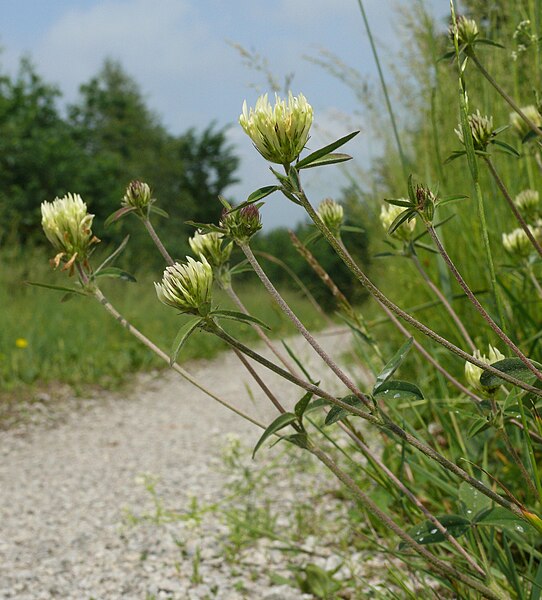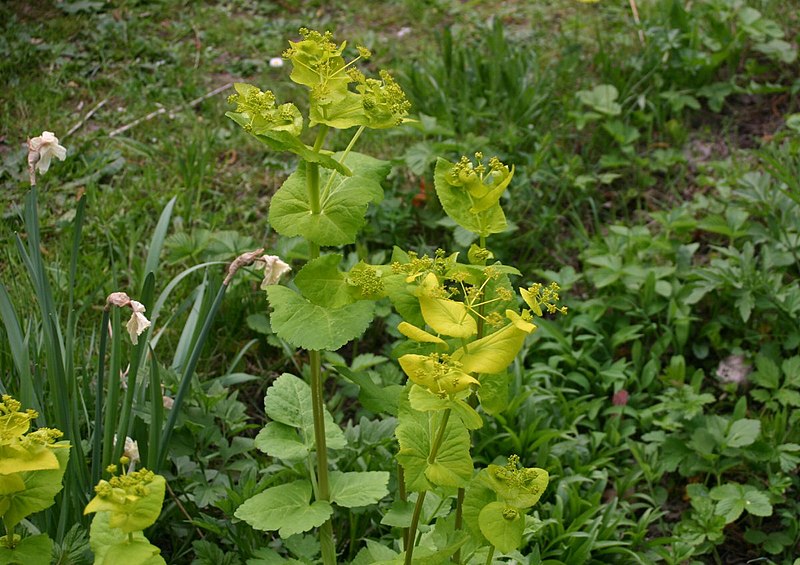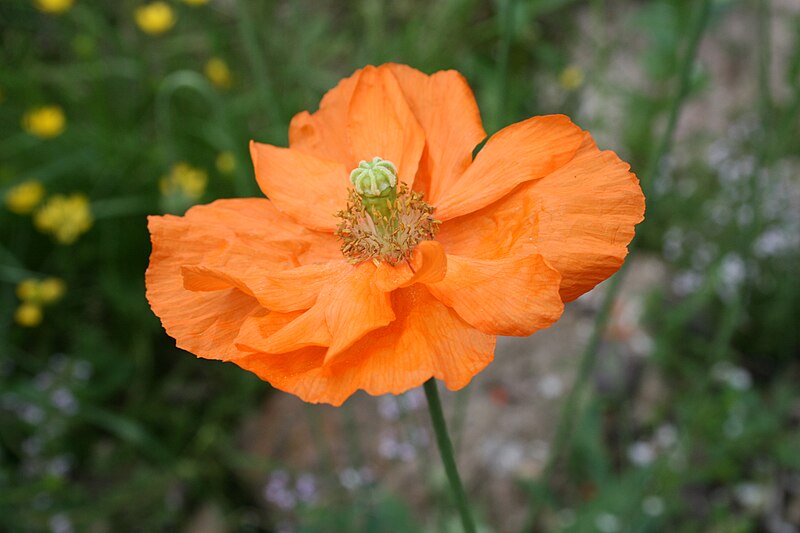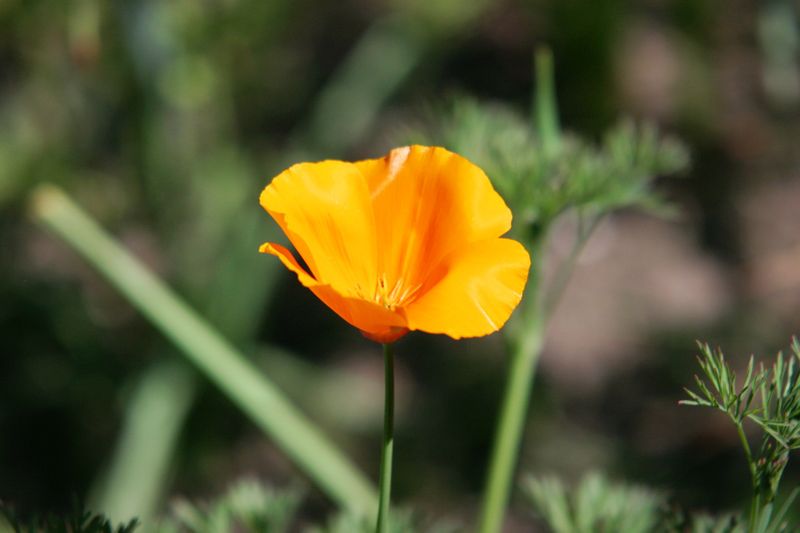St Aidan's is still throwing up surprises and today was no exception with this unusually pale-flowered form of Yellow Iris (Iris pseudacorus var. bastardii). I was going to make a joke of the unfortunate name until I realised it was likely named to honour the French botanist Toussaint Bastard.
I was even more pleased with my find when I realised it was just inside VC64, Until the recent update of the relevant OS map it wasn't clear that this waterbody was wholly in VC64.
I am the Botanical Society of Britain and Ireland (BSBI) Vice-County Recorder for Huntingdonshire (VC31) and Mid-West Yorkshire (VC64). I've set-up this botany blog to more readily share news on recent wildflower discoveries made by myself and others, to encourage wider recording, and as a way to challenge myself to take more photographs of the plants I find. See the BSBI website for more information on the work of the society and the diverse range of botany projects currently in progress.
Sunday, 26 June 2016
Recent News - Huntingdonshire
Brian Davis has been to Kimbolton Airfield and refound the Nationally Scarce Slender Tare (Vicia parviflora) after a 20 year gap of records from the relevant tetrad. This species should be kept at the back of ones mind at this time of year when botanising on the clays across the centre of the county, particularly if there is lots of Smooth Tare (Vivia tetrasperma). It often grows with and is disguised by this latter species.
Brian sent the following compare and contrast image which, while I'm sure he won't mind me saying isn't a classically great photo, does show the characteristics of the species (albeit with no mature seed pods to show >4 seeds per pod in parviflora) much better than the multitude of photos viewable via Google.
Brian also refound Sulphur Clover (Trifolium ochroleucon), another notable, albeit much diminished in recent years, species of the Huntingdonshire clays.
Brian sent the following compare and contrast image which, while I'm sure he won't mind me saying isn't a classically great photo, does show the characteristics of the species (albeit with no mature seed pods to show >4 seeds per pod in parviflora) much better than the multitude of photos viewable via Google.
Slender Tare (left) versus Smooth Tare (right)
Brian also refound Sulphur Clover (Trifolium ochroleucon), another notable, albeit much diminished in recent years, species of the Huntingdonshire clays.
Photo as published on Wikimedia Commons by Bernd Haynold
Meanwhile, Barry Dickerson has been to a favourite spot on his local patch - the area known as railway meadow. This site continues to develop botanical interest and the orchids are thriving this year.
Barry reports 13 Common Spotted-orchids (Dactylorhiza fuchsii), 72 Bee Orchids (Ophrys apifera), 135 Pyramidal Orchids (Anacamptis pyramidalis) and a single Southern-orchid (Dactylorhiza praetermissa). A photo of a fine stand of Pyramidals was sent by Barry and is presented below.
Finally, Jane Croft has followed up my tip-off on the presence of Thick-leaved Stonecrop (Sedum dasyphyllum) at Buckden Towers, and immediately returned news of its presence in the Knot Garden. I have seen this species previously on the old wall by the main gate and on the ground by the church. This is the only known site in the county and it was first reported here in 1762. Jane sends this photo.
The tenure of the stonecrop has been nearly as long as that of the magnificent London Plane (Platanus x hispanica) in the grounds. These enormous trees are likely to be the oldest in the country and deserve to be better known. More information is available here.
Sunday, 19 June 2016
Abyssinian Mustard New to VC64
Mike Wilcox has been keeping an eye on a Brassica at Apperley Bridge for a while. He was convinced it was Abyssinian Mustard (Brassica carinata), but needed mature fruit to confirm the ID. But its now official. A very interesting find of a casual so rare it only merits one paragraph in the BSBI Handbook, indeed current records in the Distribution Database suggest that as well as being a VC first it is also now the most northerly record for Great Britain. Photo provided by Mike below.
Perfoliate Alexanders New to Huntingdonshire
Jessica Hatchett of the Wildlife Trust has sent news of a recent find of Perfoliate Alexanders (Smyrnium perfoliatum) when surveying Coppingford Lane (VC31). This is a surprising location for the first VC record of this species given, with the exception of a nearby farm, it is distant from habitation.
This species is scarcely recorded away from the Greater London area where it can be very abundant, but there are a few records for Cambridgeshire.
This species is scarcely recorded away from the Greater London area where it can be very abundant, but there are a few records for Cambridgeshire.
Photo by Sten Porse from Wikimedia Commons
Sunday, 12 June 2016
Red-hot-poker by the Aire & Calder Navigation (VC63)
I found this surprise today growing amongst wetland vegetation at the edge of the canal in Water Haigh Woodland Park, Woodlesford. I would not normally take Greater Red-hot-poker (Kniphofia x praecox), note the longly exserted stamens, for a wetland plant but it seemed quite happy.
Saturday, 11 June 2016
Mean Streets
Urban botanising doesn't appeal to many, myself included. However, they can be rewarding areas and certainly they need to be covered if we are not to overlook what is a major, albeit predominantly artificial, suite of habitats that can, and often do, have their own botanical interest. So we need to find a balance between the desire to bypass urban areas on route to greener hunting grounds, and the need to record these areas as thoroughly as any other habitat.
I think part of the trick is to make the most of our necessary trips into urban areas - what do we notice when we go in for other purposes and what's present on our own doorsteps? Over the last few months I've been making the most of my half hour lunch breaks and taking a regular walk around the streets and paths within (at most) a 500m radius of my office in Holbeck, Leeds (VC63). I've been surprised what I've found and I hope the following, with a little help from Wikimedia Commons, inspires others to do something similar. Here are a few of the highlights to date.
I think part of the trick is to make the most of our necessary trips into urban areas - what do we notice when we go in for other purposes and what's present on our own doorsteps? Over the last few months I've been making the most of my half hour lunch breaks and taking a regular walk around the streets and paths within (at most) a 500m radius of my office in Holbeck, Leeds (VC63). I've been surprised what I've found and I hope the following, with a little help from Wikimedia Commons, inspires others to do something similar. Here are a few of the highlights to date.
New Zealand Bittercress (Cardamine corymbosa) (photo by Bernd Sauerwein)
Keeled-fruited Cornsalad (Valerianella carinata) (photo by Stefen Lefnaer)
Atlas Poppy (Papaver atlanticum 'Semiplenum') (photo by Uleli)
Californian Poppy (Eschscholzia californica) (photo by JeLuF)
Welsh Poppy (Meconopsis cambrica 'Aurantiaca') (photo by Svdmolen)
Eastern Rocket in its 1000's (Sisymbrium orientale) (photo byKurt Kulac)
Rat's-tail Fescue (Vulpia myuros) (photo by Harry Rose)
Small Toadflax (Chaenorhinum minus) (photo by Stefan Lefnaer)
Tutsan (Hypericum androsaemum) (photo by Kenpei)
Wednesday, 8 June 2016
Exciting Finds on Staughton Moor (VC31)
Pete Stroh has been down in the arable 'prairies' of Staughton Moor in the far south of Huntingdonshire. Its well away from the botanical hotspots of the county so is under investigated, but it does have its own character and is the centre of distribution in the county for the rare Spiked Star-of-Bethlehem (Ornithogalum pyrenaicum).
Pete's trip was motivated by the need to record his plots for the National Plant Monitoring Scheme. His arable plot turned out to be a disappointment this year with nothing present but the wheat crop. However, not far away he found thriving populations of two county rarities. These were Bur Chervil (Anthriscus caucalis) which was over-topping the crop in places, and the even rarer Shepherd's-needle (Scandix pecten-veneris). Pete providing the following photos to share. If anyone else has spotted either of these two species in VC31 (or VC64) I would be pleased to receive details.

Pete's trip was motivated by the need to record his plots for the National Plant Monitoring Scheme. His arable plot turned out to be a disappointment this year with nothing present but the wheat crop. However, not far away he found thriving populations of two county rarities. These were Bur Chervil (Anthriscus caucalis) which was over-topping the crop in places, and the even rarer Shepherd's-needle (Scandix pecten-veneris). Pete providing the following photos to share. If anyone else has spotted either of these two species in VC31 (or VC64) I would be pleased to receive details.

Shepherd's-needle (photo by Pete Stroh)
Bur Chervil over-topping the wheat crop (photo by Pete Stroh)
Bur Chervil (Photo by Curtis Clarke as published on Wikimedia Commons)
Monday, 6 June 2016
Garden Star-of-Bethlehem at Royds Green (VC63)
One of my regular walks threw up a surprise this Sunday, adding Garden Star-of-Bethlehem (Ornithogalum umbellatum subsp. umbellatum) to my local list. It also seems to be a new hectad record and perhaps the first record of the subspecies for VC63.
I found a single small plant on a shaded road verge near the school at Royds Green, although other plants may be present in the woodland further back from the pavement. This subspecies has larger showier tepals than Star-of-Bethlehem (subsp. campestre), the form that is considered native in parts of Britain.
I found a single small plant on a shaded road verge near the school at Royds Green, although other plants may be present in the woodland further back from the pavement. This subspecies has larger showier tepals than Star-of-Bethlehem (subsp. campestre), the form that is considered native in parts of Britain.
Griffith's Spurge at Golden Acre (VC64)
May and June are pretty frantic months so I've not had time to post much news recently, but good records are still being made and sent in. As a quick post, Mike Wilcox's sharp eyes recently spotted the stunning Griffith's Spurge (Euphorbia griffithii) in a marshy area away from the formal gardens of Golden Acre Park. This is a new location and the third record for the VC. Thanks to Mike for the photo.
Subscribe to:
Comments (Atom)













.jpg/800px-Meconopsis_cambrica-03_(xndr).jpg)

.jpg/800px-Vulpia_myuros_plant3_(7429500698).jpg)






